AFFILIATE MARKETING
10 Best Text To Image AI Tools to Unlock Your Creative Potential in 2023

Do you need images for your website or other digital projects but don’t have the time or resources to create them yourself? Or perhaps you’re looking for a way to create stunning visuals that enhance your words and keep readers on the page? You’re lucky because this article highlights the best text-to-image AI art generators!
These powerful applications use artificial intelligence (AI) algorithms to generate high-quality images from language descriptions or texts with no manual labor needed.
With these amazing AI image generators, you can quickly turn any concept into eye-catching photo-realistic images that will spark engagement with your audience.
Let’s dive in…
Best Text-to-Image AI Tools
Here are some of the best text-to-image AI tools that you can use to create stunning visuals for your content:
1. Jasper
If you haven’t heard of Jasper AI writing assistant by now, you must have been living under a rock for the past few years. But did you know this amazing AI-powered writing assistant also now has a built-in image generator? It’s like having a creative writing genius and a digital artist in one!
Jasper’s text-to-art image generator can take text inputs and turn them into stunning visuals in just a few seconds.
Unlimited generations with Jasper Art AI image creator are included in every Creator, Teams, and Business subscription, starting from $39/mo.
Check out what else Jasper has to offer in our full Jasper review, or take a look at our Jasper Art Review.
You can even get started for free today with a 7-day trial!
2. Canva
Canva has earned a reputation as the ultimate weapon for non-designers who want a user-friendly alternative to Adobe Photoshop. However, they have also developed an impressive AI text-to-image editor to output images.

With Canva Text to Image, you have a variety of styles to choose from when generating an image. You can select your preferred size or aspect ratio and quickly turn text into photorealistic images with the help of its AI algorithm.
Free users can unlock the power of Text to Image with up to 50-lifetime queries. Those with a Canva paid plan can unleash 500 queries per user per month.

Canva paid plans start from $14.99/mo.
Check out our full Canva review to find out what else this go-to design tool has to offer.
3. NightCafe

NightCafe is an online art studio that uses AI to create personalized artwork. It was founded by Angus Taylor in 2019 with the idea of using AI to make fully customizable art.
The name NightCafe pays homage to Vincent Van Gogh’s famous painting of the same name.
And in 2021, they introduced text-to-image art creation methods, which exploded in popularity. They now have printing and warehousing partners worldwide, with headquarters in Cairns, Australia.
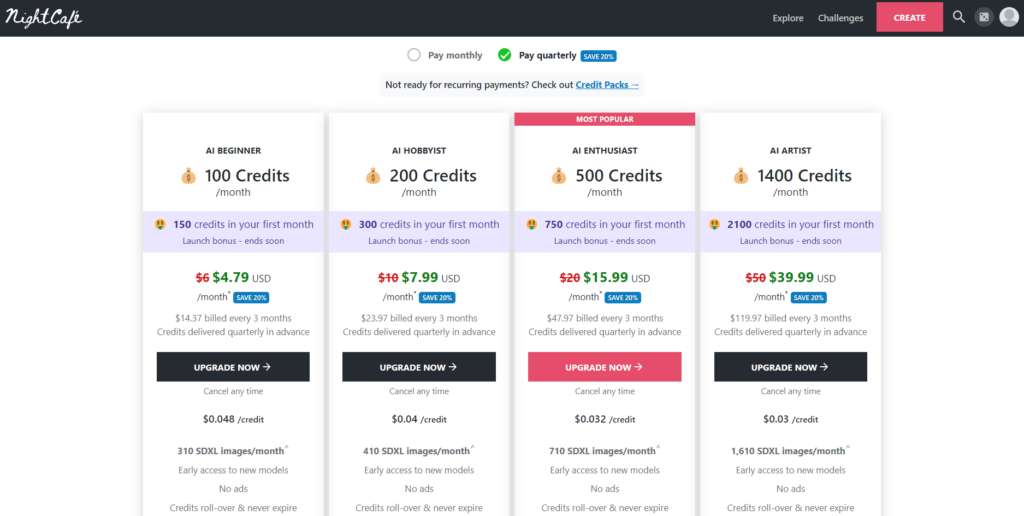
This AI image generator works on a credit system, with credits available via monthly subscriptions from $4.79/mo or one-off purchases of credit packs.

4. Picsart
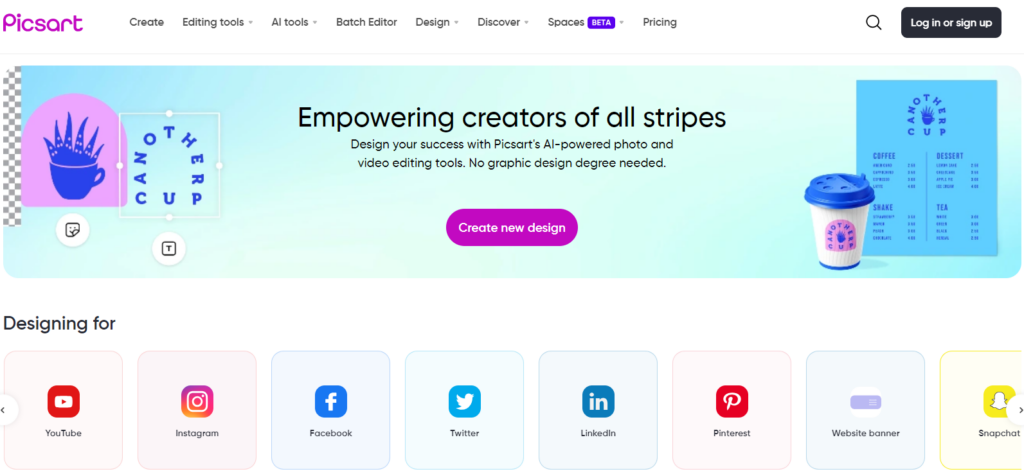
With 150 million active users worldwide every month, Picsart is an amazing platform that lets you create, customize, and share images and videos. It’s super user-friendly, perfect for creators of any skill level, and works on both mobile and web.
Picsart offers a “freemium” model, so you get a bunch of free features and tools.
If you want to take your creativity to the next level, you can upgrade to a paid membership from $5/month for unlimited access to all the advanced photo and video editing tools.

5. Starry AI

StarryAI is an AI art generator that allows users to create unique images using text prompts. It utilizes two machine learning models, CLIP and Diffusion, to generate high-quality, coherent images from your text descriptions.
By combining these two models, StarryAI creates unique and original images with a depth and complexity that far surpasses what traditional AI-generated images are capable of. Plus, Starry AI users can use an initial image to create AI art in conjunction with the text prompt for a truly unique final image that really fits the brief.
StarryAI is a free AI image generator, and you can generate up to 5 artworks daily without any watermarks.
You can generate more images with a paid plan of Starry AI Pro for $11.99/mo.
6. Dream by Wombo
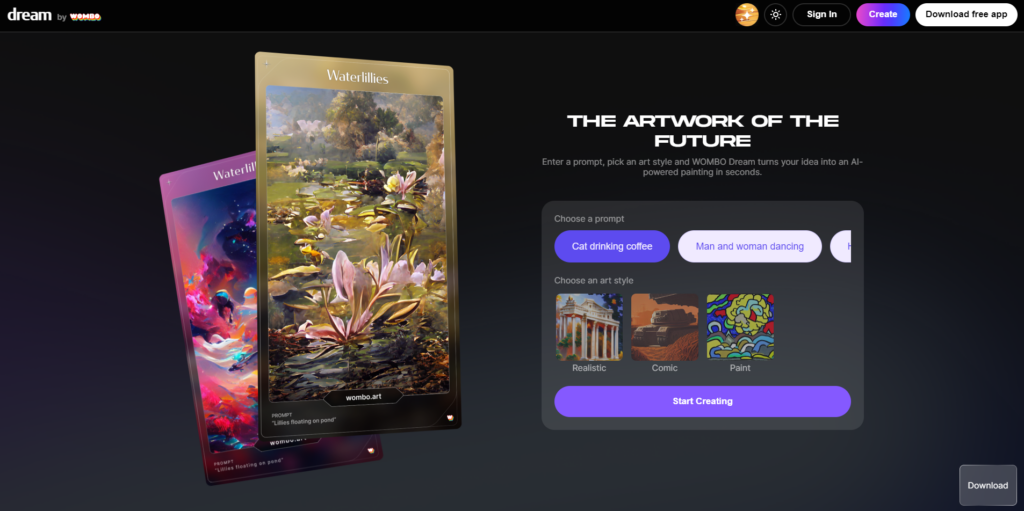
Wombo, a Canadian company renowned for its AI-powered lipsyncing video app, has recently introduced Dream by Wombo. WOMBO Dream AI Art Generator lets you create stunning digital artwork and photos effortlessly. Simply enter a prompt, select an art style, and watch your ideas come to life in seconds.
The free version of this AI image generator app allows you to create one image and choose from different art styles. With the paid version, you can generate four images at once, enjoy an ad-free experience, and get faster results. There are iOS and Android apps available for convenient mobile use.
Visit the Dream by WOMBO website and click the “Create” button. Alternatively, you can select the yellow circle icon in the header to set up a paid account.
Choose from Dream subscription options: $9.99 per month, $89.99 per year, or $169.99 for a lifetime subscription.
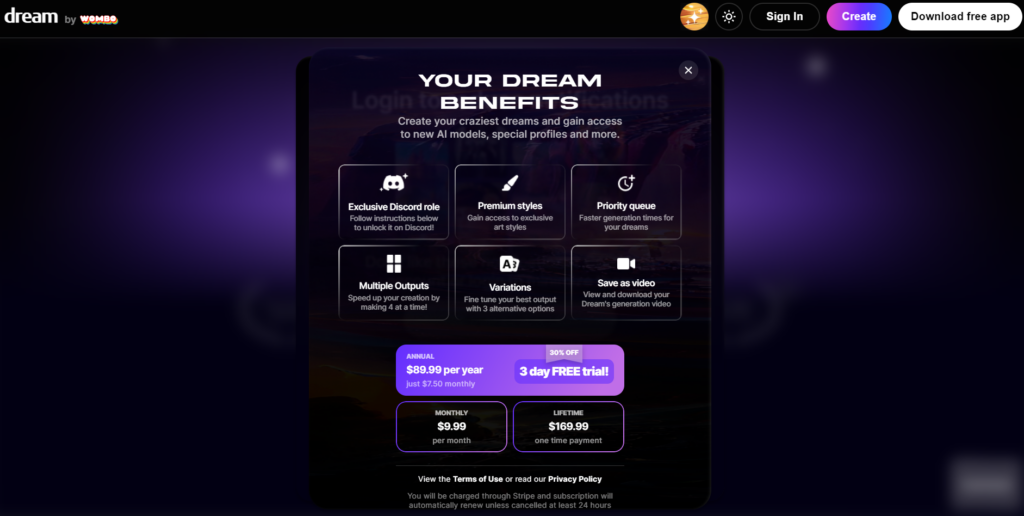
7. Stable Diffusion
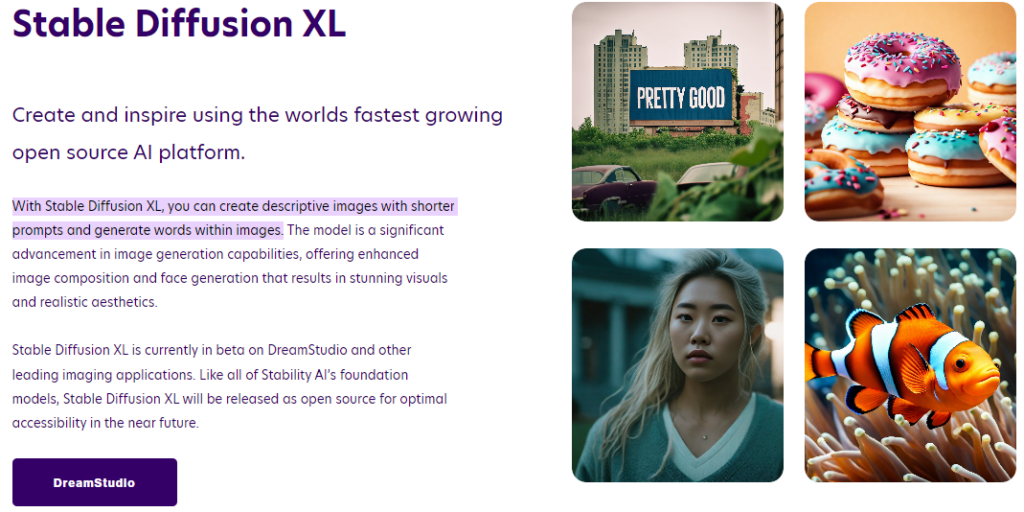
Stable Diffusion is one of the leading names in AI-generated art and describes itself as the world’s leading open-source generative AI company. The company has its own online platform and Android and iOS apps that allow you to access its services on the go.
Stable Diffusion XL, the latest iteration, offers the most seamless creation of descriptive images yet using concise prompts, enabling word generation within images.
This advanced AI image generator model signifies substantial progress in image generation capabilities, delivering enhanced image quality and face generation for striking visuals and lifelike aesthetics.

Stable Diffusion provides both free and paid versions. The free version, called Stable Diffusion Web UI, can be easily accessed through a web browser without the need for any subscription or licensing fees.
If you need more features, there are paid plans available. Choose from three subscription options:
– Basic Plan: $9/month
– Standard Plan: $49/month
– Premium Plan: $149/month
For those with more extensive requirements, enterprise options are also available.
8. Craiyon (Previously DALL·E Mini)

Craiyon is an AI text-to-image generator that lets you create amazing works of art with just a few keywords. It uses advanced deep learning and generative AI models to turn your words into images.
Craiyon turns writing into beautiful visuals, allowing anyone to express their creativity.
That’s why Craiyon is perfect for content creators, marketers, and artists alike who need creative visuals to express their stories. They’re also constantly improving their AI models and features, so with Craiyon, anyone can become an artist – no experience required.
Enjoy generating 9 free images per month, or upgrade to a paid subscription from $5/mo for unlimited artwork, fewer ads, and faster generation.

9. Midjourney

Midjourney is a forward-thinking research lab that aims to push the limits of human imagination and explore innovative ways of thinking. Their small, self-funded team focuses on design, human infrastructure, and AI. With 11 full-time staff members and a lineup of awesome advisors, they’re dedicated to pioneering new ideas and shaping the future.
The Midjourney AI image generator is accessible via their discord server, where users provide text prompts to help guide the process of creating realistic images.
While Midjourney offers free access to its AI art generator, it can be a bit tricky to get in on the action due to the overwhelming demand.
Take a look at our detailed Midjourney review for full info on this AI tool’s capabilities.
Midjourney offers a paid plan for $10 per month, giving you 3.3 fast hours to work with.
Each fast hour allows you to generate around 60 images, so with the Basic Plan, you’ll be able to create approximately 200 images. But you can always buy extra hours for $4/hour.
The next level up is the Standard Plan, priced at $30 per month and allows 15 fast hours/month.

10. Deep Dream Generator

Deep Dream Generator is an online platform that leverages AI technology and art to bring your imagination to life. With its user-friendly tools, you can effortlessly create captivating images and share them with a community of fellow artists and explorers. Unleash your creativity and unlock the boundless possibilities of AI-generated art!
Every default quality image generated consumes 5 power points. You can get power points by choosing a monthly subscription plan or making one-time purchases.
You have the option to subscribe on a monthly basis and buy energy packs whenever you need them.

Conclusion – Best AI Image Generators
While there are free text-to-image generators, as these have increased in popularity, there has been a corresponding rise in issues such as laggy generation and being unable to access the service or create free accounts at high-traffic times.
In the past, many art generators used to offer unlimited creations completely free. However, as more users requested and used the services, it became evident that unlimited free digital art was not sustainable.
Because processing creations require significant computing power, which comes at a cost, most providers, including the AI image generators listed here, have resorted to pay-as-you-go or subscription models.
But rest assured that as art generator tool algorithms become more optimized and computing power becomes more affordable, the cost of AI image generation will inevitably decrease.
And as demand increases, providers have started exploring other ways to support free users.
However, this has resulted in some complaints from users of free versions of image generation tools. They have been experiencing limitations on the number of characters and seeing NSFW ads. Additionally, the lag times on many free AI image generators can be frustrating, as paid subscribers are prioritized.
This is why investing in one of the best ai image generators will provide a reliable, quick service you can trust.
For those looking for reliable image generation tools that provide a great user experience with minimal issues, premium offers from experienced tools like Jasper and Canva are the best ai art options.
FAQ
Here are some answers to the most frequently asked questions about AI image generators:
Are AI-Generated Images Illegal?
AI images are not illegal, but there have been lawsuits against certain AI image labs. Artists argue that AI images infringe on their copyright because they were trained using unauthorized images.
Do I Own the AI Art That I Create?
No. According to the U.S. Copyright Office, works produced by non-human entities, such as machines, have historically not qualified for copyright protection. Consequently, the images created by AI image generators are not subject to copyright, so technically while you can USE the AI-generated image, you might not actually OWN it.
The AI image creation landscape is fast changing – including the laws, so it’s best to check with your local jurisdiction and/or the AI provider for the latest information.
How Can I Make Money With AI Art?
Are you looking for a new way to create images and make money? With AI-generated art, you can generate a steady income from your skill and creativity! From designing logos and banners to creating merchandise for physical products, there are tons of opportunities out there.
You could even write and illustrate your own children’s book using ai image generators. And if you want to get into print-on-demand products, you can generate images to create beautiful printables such as invitations, postcards, and posters.
With AI art, the possibilities are endless! So, if you’re looking for a way to start a side hustle or monetize your creativity with the help of an AI generator tool, this could be the perfect solution for you.

![How AEO Will Impact Your Business's Google Visibility in 2026 Why Your Small Business’s Google Visibility in 2026 Depends on AEO [Webinar]](https://articles.entireweb.com/wp-content/uploads/2026/01/How-AEO-Will-Impact-Your-Businesss-Google-Visibility-in-2026-400x240.png)
![How AEO Will Impact Your Business's Google Visibility in 2026 Why Your Small Business’s Google Visibility in 2026 Depends on AEO [Webinar]](https://articles.entireweb.com/wp-content/uploads/2026/01/How-AEO-Will-Impact-Your-Businesss-Google-Visibility-in-2026-80x80.png)















